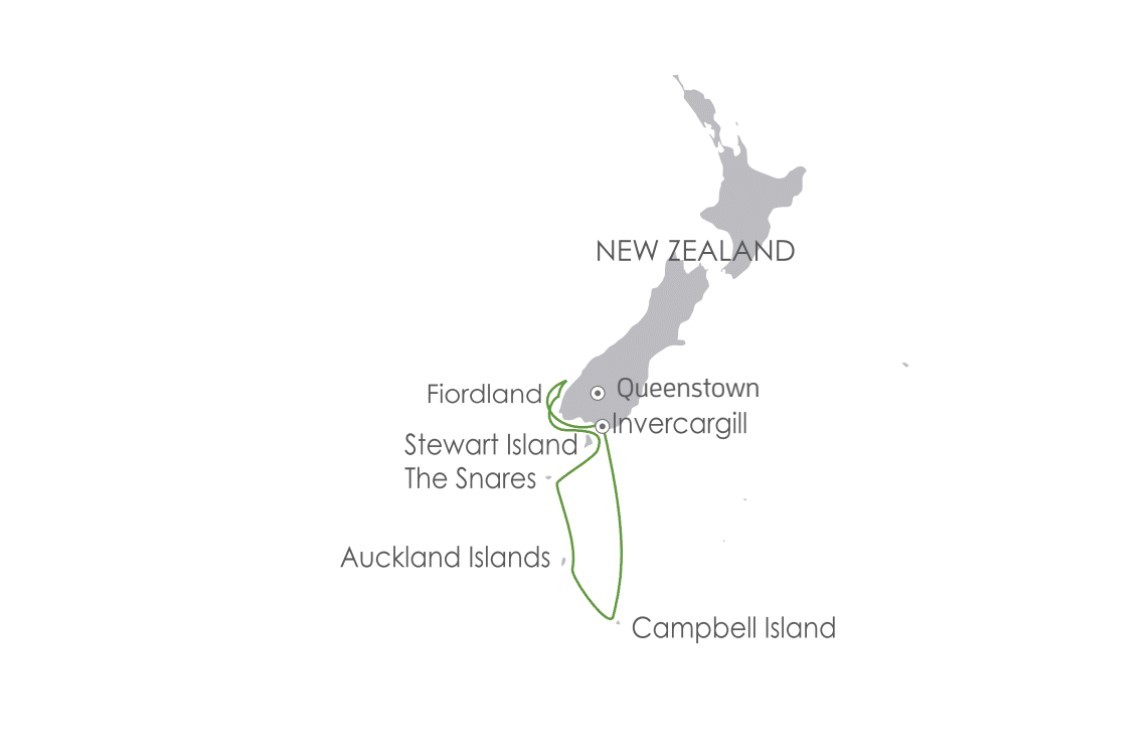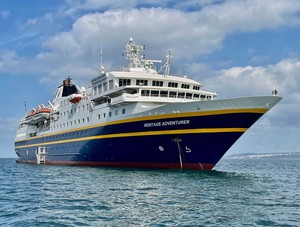
Explore New Zealand's Subantarctic Auckland, Snares and Campbell Islands along with the untamed wilderness of Fiordland's ice-carved mountains, forests and fiords. Encounter threatened native species flourishing on Stewart Island's Ulva Island on this iconic, 12-day expedition cruise of remote New Zealand.
Heritage Expeditions pioneered expedition cruising in 1984 by cruising the rugged and unique southern coastline of New Zealand's South Island, including Fiordland and Stewart Island. From those first days exploring the wilderness from their tiny yacht base with just 5 travellers aboard, the Russ family realised their dream that responsible tourism, enacted in a genuine and responsible way in conjunction with local government, had the ability to assist in the protection of vulnerable areas. From there, Heritage Expeditions continued to grow escorting conservation-minded passengers to the world's most special regions, from Antarctica to the Arctic, but our passion for New Zealand's wilderness never diminished.
Reinstated in 2018, this expedition returns, in full circle, to where Heritage Expeditions' legacy began. Exploring the remote ice-carved mountains, verdant forests and winding fiords of Fiordland, it is easy to see why this incredible region inspired our dream for responsible travel. In the calm waters of Fiordland, and away from the crowds, there are great opportunities to lookout for marine life, elusive birds and stunning vistas.
This expedition also includes New Zealand's Subantarctic Islands, which has been a popular and essential part of Heritage Expeditions' programme for many years, and Stewart Island's Ulva Island that is home to a range of birdlife and free of introduced pests. Tick this once in a lifetime experience off your travel bucket list; explore remote parts of New Zealand's Southern region, an area known for its range of birdlife and jaw dropping scenery on a grand scale.
The Subantarctic Islands are the wildlife and history rich regions of Southern New Zealand, they are impossible to visit without an expedition like this. They are not mentioned in a travel brochure on your high street; and rarely will you find them listed in guidebooks, few people have been to them and they don't even appear on some maps of the South Pacific. Despite their low profile, they are among the most remarkable wildlife reserves in the New Zealand, designated UNESCO World Heritage sites and afforded the highest protection of any nature reserves in New Zealand. Remote, uninhabited and on no regular shipping route, access is further restricted by a strict Management Plan which limits the number of people allowed ashore each year.
- Visit Campbell Island
- Enjoy Auckland Island
- Explore The Snare
- Discover Fiordland
Prices quoted here are often dependent on currency fluctuations. Please check with (01432 507450 or info@small-cruise-ships.com) for the very latest price, which may well be cheaper than the one advertised here.
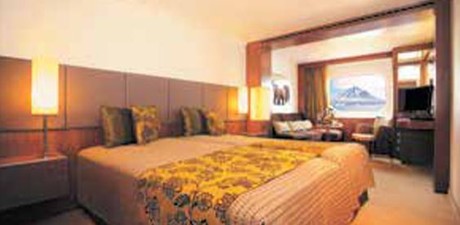
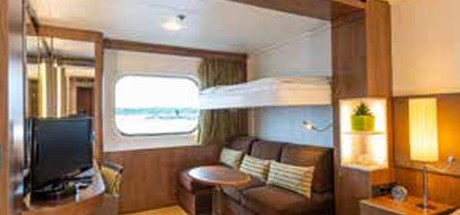
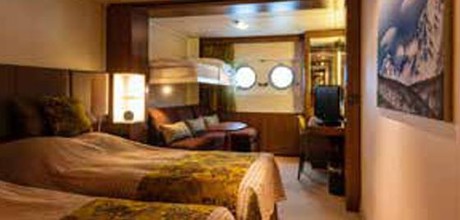





Guests should make their way to the designated hotel where we will spend the first night of the expedition. This evening there will be an informal get-together at the hotel for dinner; an excellent opportunity to meet fellow adventurers on your voyage and some of our expedition team.
Today we enjoy breakfast in the hotel restaurant and have the morning free to explore Queenstown before returning to the hotel for lunch and departing for the Port of Bluff to embark your ship. You will have time to settle into your cabin and familarise yourself with the ship; we will also take the opportunity to conduct a number of safety briefings. You are invited to join the expedition team in the Observation Lounge and up on the Observation Deck as we set our course to Campbell Island and our adventure begins. We will sail past Ruapuke Island, formerly a local Maori stronghold supporting a population of over 200 people. We will also be able to see Stewart Island. Despite appearing quite small on most maps it is really quite large and has a 700 kilometre coastline. Seabirds that we may encounter at this early point in the voyage include: albatross, petrels, cormorants, gulls, and Little Blue Penguins.
As we make our way through the Southern Ocean we take the opportunity to learn more about the flora and fauna as we prepare for our arrival at Campbell Island. En route there are great birding opportunities which may include the Wandering Albatross, Royal Albatross, Black-browed Albatross, Light-mantled Sooty Albatross, Salvin’s Albatross, Campbell Island Albatross, Northern and Southern Giant Petrel, Sooty Shearwater and Little Shearwater. There should be plenty of petrels and again the hard to identify prion species. We can expect some of the best pelagic birding on this leg of the journey from Bluff to Campbell Island with great views during the crossing.
We have a full day to explore Campbell Island, New Zealand’s southernmost Subantarctic territory. Its history is as rich and varied as the other islands we visit. Discovered in 1810, it was soon occupied by sealers who introduced rats and cats. Farming followed from 1895 to 1934 when it was abandoned. Coastwatchers were stationed on the island during the war and at the end of the war the station was taken over by the New Zealand Metrological service. They maintained a manned weather/ research station there until 1995. In the early 1970s the removal of farm animals commenced and all were eventually removed by 1990. The vegetation recovered quickly and the cats died out naturally. In a very ambitious (and never before attempted on such a large scale) eradication programme the New Zealand Department of Conservation successfully removed the rats. With the island declared predator free, the way was clear to reintroduce the endangered Campbell Island Flightless Teal, which had been rediscovered on an offshore island in 1975. Snipe, which were formerly unknown from the island but were discovered on another offshore island, recolonised the islands themselves. The vegetation which the great English botanist Sir Joseph Hooker described in 1841 as having a “Flora display second to none outside the tropics” is flourishing and is nothing short of spectacular. We will offer a number of options which will enable you to explore the island including an extended walk to Northwest Bay. There will also be an easier walk to the Col Lyall Saddle. All of these options will allow you the opportunity and time to enjoy the Southern Royal Albatross which nest here in large numbers. We also visit areas of the island which contain outstanding examples of the megaherbs for which the island is renowned.
In the south of the archipelago there is a very large sheltered harbour rich in human history including shipwrecks, treasure hunters, Coastwatchers and, of course, scientific parties. We plan to arrive mid-morning entering the harbour through the eastern entrance which is guarded on both sides by dramatic cliffs and months before sailing their modified dinghy to New Zealand to get help. Two of the survivors wrote books about their ordeal, their first-hand accounts tell us a lot about their time here. Later this evening we will sail up the eastern coast, making our way to Port Ross in preparation for our landing at Enderby Island. rugged, tussock-covered hills. Our activities here today are weather dependent. We have a number of options. If the weather is fine there will be an opportunity for the more energetic expeditioners to climb to the South West Cape and visit the Shy Mollymawk colony. This climb provides magnificent views in all directions, especially over the western entrance to Carnley Harbour, Adams Island and Western Harbour. For those not making the climb there will be an opportunity to Zodiac cruise along the coast of Adams Island, Western Harbour and Victoria Passage. Other options include the Tagua Bay Coastwatcher’s hut and lookout which was occupied during the Second World War. We could visit Epigwatt and the remains of the ‘Grafton’ which was wrecked here in 1864. All five men aboard survived and lived here for 18
The Auckland Islands group was formed by two volcanoes which erupted some 10-25 million years ago. They have subsequently been eroded and dissected by glaciation creating the archipelago as we know it today. Enderby Island is one of the most beautiful islands in this group and is named after the same distinguished shipping family as one of our own vessels. This northern most island in the archipelago is an outstanding wildlife and birding location and is relatively easy to land on and walk around. The island was cleared of all introduced animals (pests) in 1994 and both birds and the vegetation, especially the herbaceous plants, are recovering both in numbers and diversity. Our plan is to land at Sandy Bay, one of three breeding areas in the Auckland Islands for the Hooker’s or New Zealand Sea Lion, a rare member of the seal family. Beachmaster bulls gather on the beach, defending their harems from younger (ambitious) males, to mate with the cows shortly after they have given birth to a single pup. Hooker’s or New Zealand Sea Lion numbers are in a slow decline, for reasons which are not obvious but most probably connected with a nearby squid fishery. During our day ashore there will be several options, some longer walks, some shorter walks and time to spend just sitting and enjoying the wildlife. The walking is relatively easy. A boardwalk traverses the island to the dramatic western cliffs, from there we follow the coast and circumnavigate the island. Birds that we are likely to encounter include the following species: Southern Royal Albatross, Northern Giant Petrel, Auckland Island Shag, Auckland Island Flightless Teal, Auckland Island Banded Dotterel, Auckland Island Tomtit, Bellbird, Pipit, Red-crowned Parakeet, Yellow-eyed Penguin and Light-mantled Sooty Albatross. There is also a very good chance of seeing the Subantarctic Snipe. Other more common species we will see include the Goldfinch, Song Thrush, Blackbird, European Starling, Red-billed Gull and Redpoll. On Derry Castle Reef we will look for migratory waders which could include Bar-tailed Godwit, Turnstone and possibly vagrants.
The closest Subantarctic Islands to New Zealand, they were appropriately called The Snares as they were once considered a hazard for sailing ships. Comprising of two main islands and a group of five islands called the Western Chain; they are uninhabited and enjoy the highest protection as Nature Reserves. It is claimed by some that these islands are home to more nesting seabirds than all of the British Isles together. We plan to arrive in the morning, and as landings are not permitted, we will Zodiac cruise along the sheltered eastern side of the main island if the weather and sea conditions are suitable. In the sheltered bays, we should see the endemic Snares Crested Penguin, Snares Island Tomtit and Fernbirds. There are hundreds of thousands of Sooty Shearwaters nesting on The Snares; the actual number is much debated. Buller’s Albatross breed here from early January onwards. There will be opportunities to view the forests of large tree daisy Olearia lyallii which forms a canopy over much of the island group.
New Zealand’s third island is well off the usual beaten tourist track. It is a wonderfully tranquil place; the scenery of untouched bushland is stunning. We will enjoy a morning exploring Ulva Island which is rich in history and wildlife, being a predator-free island from 1997 the bird song and wildlife is some of the best. In Paterson Inlet you will have time to explore the sandy beaches of Boulder Bay and West End Beach or just enjoy some time around Post Office Bay and Sydney Cove. Some of the wildlife you may get to see while walking the tracks on Ulva Island include Stewart Island Robin, Stewart Island Weka, South Island Kaka, Kereru (wood pigeon), Mohua (yellowhead), Red Crowned Parakeet, Fantail, Bellbird and Tui. There are many more species that may also be seen, our knowledgeable expedition guides will be listening for bird calls and keeping a close watch in overhead canopies and the surrounding shrubs to identify further species. In the afternoon we turn our attention to other parts of Paterson Inlet and visit the historic Norwegian whaling station in Prices Inlet and Kaipipi Bay, where from 1923 and 1933 the Ross Sea Whaling Company of Sandefjord, Norway ran a repair base in Prices Inlet where chaser boats were serviced in preparation for the Antarctic summer. There may be an opportunity to explore quirky town centre Oban in Halfmoon Bay where a drink with a view can be enjoyed at the iconic South Sea Hotel.
We have three days to explore the incredible wilderness of fiords in the south-west corner of the South Island. This is an area rich in history, majestic scenery and abundant in wildlife. Fiordland was well known to local Maori people, with the demi-god Tu-te-raki- whanoa being said to have used his adze, Te Hamo, to carve out the region’s fiords. Captain Cook and his crew landed here on HMS Resolution in 1773, they were the first Europeans to visit Fiordland, subsequently spending five weeks in Dusky Sound. Cook’s records of his discovery and maps attracted sealers and whalers not long after who then formed the first European settlements of New Zealand, historically this region is very important and shaped the future of the country. From the middle of the 19 th Century this unexplored interior Fiordland coastline attracted the attention of those in search of hidden greenstone or New Zealand jade, and surveyors seeking to understand this region further. Fiordland’s West Coast is only accessible by sea, making it the most remote region of New Zealand’s mainland. Waterfalls, streams, rivers and fiords are enveloped with misty veils that come and go, revealing steep gradients of mountain peaks and sheltered valleys. A rugged terrain, the thickly forested floors are covered with ferns, lichens and mosses. Bottlenose Dolphins, Fiordland Crested Penguins and Little Penguins are all residents of the fiords; during our time here we will look out for them. Our schedule gives us the flexibility to visit as much as possible, areas we plan to visit during our time in Fiordland include Doubtful and Dusky Sounds, Acheron Passage, Astronomer’s Point and Pickersgill Harbour. Our final plan will be determined by the weather. The Captain and Expedition Leader will work hard to make the best use of our time in this incredible region of New Zealand, including areas that even few New Zealanders have visited. The isolation of Fiordland has been beneficial because its beauty remains unspoiled and its historic sites undisturbed. Tonight we enjoy a farewell and celebratory dinner with newfound friends with time to reflect on a wealth of new experiences and recap on what amazing wildlife, plant life, landscapes and history we have enjoyed.
Early this morning we will arrive in the Port of Bluff. After a final breakfast we bid farewell to our fellow voyagers and take a complimentary coach transfer to either Invercargill or Queenstown Airports. In case of unexpected delays due to weather and/or port operations we ask you not to book any onward travel until after midday from Invercargill and after 3pm from Queenstown.
During our voyage, circumstances may make it necessary or desirable to deviate from the proposed itinerary. This can include poor weather and opportunities for making unplanned excursions. Your Expedition Leader will keep you fully informed. Landings at the Subantarctic Islands of New Zealand are by permit only as administered by the Government of New Zealand. No landings are permitted at The Snares.
Heritage Adventurer

| Length | 124 |
|---|---|
| Built / renovated | 1991/2021 |
| Ice classification | Lloyds 1AS, GL E4 |
Heritage Adventurer is a true pioneering expedition vessel of exceptional pedigree. Often referred to as the ‘Grande Dame of Polar Exploration’ due to her celebrated history and refined design, she was purpose-built for adventure in 1991 at Finland’s Rauma shipyard and specifically designed for Polar exploration.Setting a peerless standard in authentic expedition travel, Heritage Adventurer (formerly known as MS Hanseatic) combines the highest passenger ship ice-class rating (1A Super) with an impressive history of Polar exploration. Having held records for the most northern and southern Arctic and Antarctic navigations, and for traversing both the Northwest and Northeast Passages, makes Heritage Adventurer perfect for pioneering experiential expedition travel. Originally designed to accommodate 184 guests, Heritage Adventurer now welcomes just 140 expeditioners ensuring spacious, stylish and comfortable voyages, while a fleet of 14 Zodiacs ensures all guests are able to maximise their expedition adventure. Heritage Adventurer proudly continues our traditions of exceptional, personalised expedition experiences as Heritage Expeditions flagship.
Observation Lounge – One of the most celebrated and best-known features of Heritage Adventurer is the awe-inducing Observation Lounge, Library and Bar. Located on Deck 7 and perched directly above the Bridge, enjoy sweeping 270-degree views through floor to ceiling windows, perfect for wildlife spotting and quick access to the outer deck. Bring your binoculars to spot wildlife, observe the ever-changing landscape, write in your journal or relax with a book.
Observation Deck – Enjoy 360-degree views from the highest point on the ship. The Observation Deck sits above the Observation Lounge and provides exceptional outside viewing options. Stretching the full width of the vessel, this is the perfect spot to take in the surrounding land and seascapes. Perfect on a sunny day, recline in the comfortable sun loungers protected from the wind and elements and watch your voyage unfold.
The Bridge – No expedition is complete without visiting Heritage Adventurer’s busy nerve centre. Located on Deck 6, Heritage Expeditions’ Open Bridge Policy means you are welcome to observe the Captain and crew at work while enjoying some of the ship’s best views. It’s a fascinating place to learn about navigation and vessel operations, however please note the Bridge will be closed when departing or arriving at port.
Dining Room – Indulge in fine international cuisine from our talented chefs in the lavish surrounds of our Dining Room on Deck 4. Sensational 270-degree views provide a stunning backdrop to meals here along with an international wine list featuring many outstanding regional wines. With relaxed seating arrangements, all guests can enjoy dining in a single sitting from hearty breakfasts setting you up for the day’s adventure to sumptuous lunches and multi-course evening dining.
Bistro – Simple fast and delicious meals and snacks are on offer in our relaxed Bistro on Deck 6. Perfect for early risers to enjoy tea, coffee and light breakfast options the Bistro provides great views and opens directly onto a covered and heated teak-deck outdoor dining area.
The Bar and Lounge – The social hub of Heritage Adventurer, the Bar and Lounge on Deck 5 features seating for all guests. Enjoy a beverage at the bar, sink into an armchair, relax on one of the many spacious loungers and watch the world go by through the panoramic windows or make new friends at the communal seating. This multi-tasking space also doubles as the location of daily briefings and evening recaps with the expedition team.
The Gym – Featuring spectacular ocean views, the well-equipped gym is adjacent to the pool, hot tub and sauna in Deck 7’s wellbeing zone. Maintain your routine with an elliptical cross trainer, treadmill, rowing machine, stationary bikes, TRX as well as free weights, yoga mats and fitness balls. Towels are provided with change room and shower amenities nearby.
Sauna and Steam Room – True to her Nordic origins, Heritage Adventurer features a dry-heat Finnish sauna and European steam room on Deck 7. Perfect for warming up post Polar plunge or unwinding after a day’s adventures, the sauna and steam room include change room facilities, showers and towels.
Swimming Pool and Hot Tub – Surrounded by relaxed teak seating including sun loungers, the open-air saltwater pool can be heated or chilled. Encased in glass the hot tub ensures all-weather use, perfect for those who like to relax with a view following a day of exploring.
Lectures and Presentations – Enjoy informative and entertaining lectures on history, biology, wildlife, and ecology in the comfort of the Presentation Theatre. With state-of-the-art audio-visual equipment, our world-renowned expedition team will bring your adventure to life through interactive presentations and discussions.


